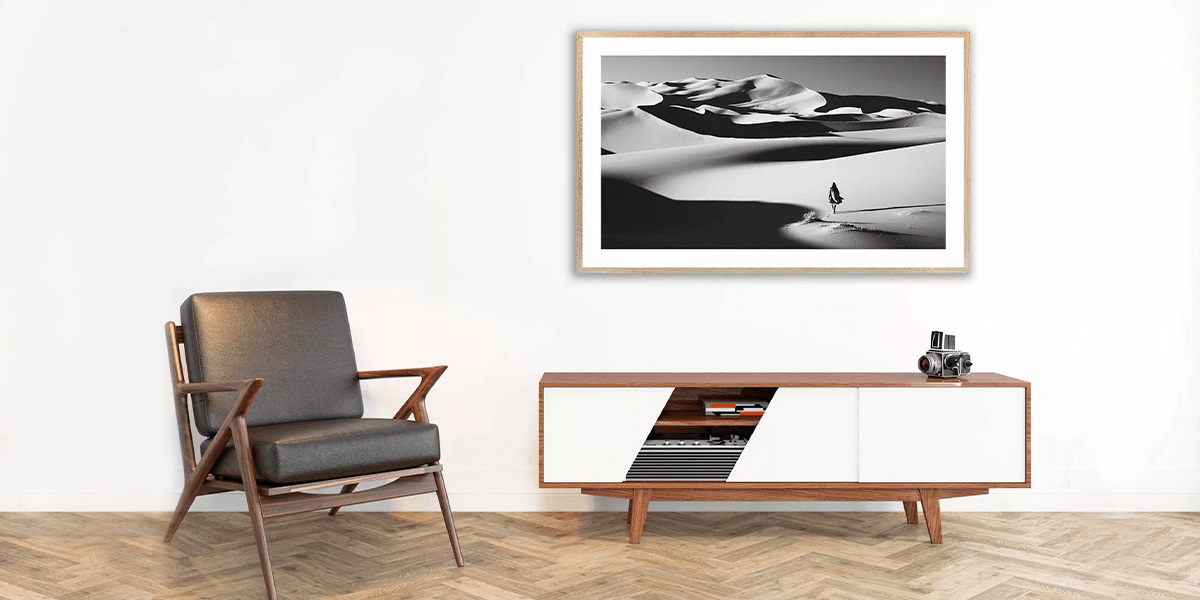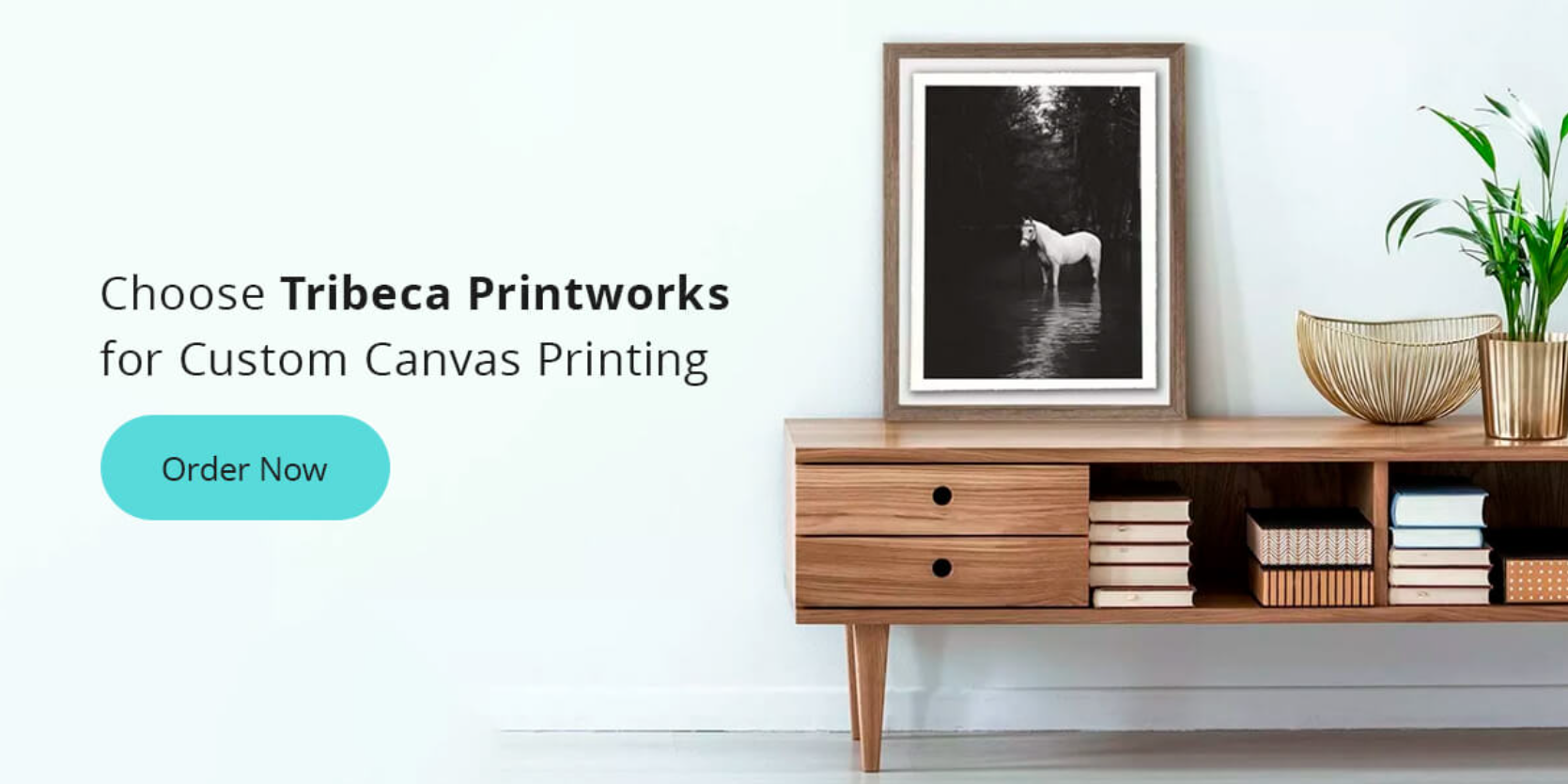How High to Hang Pictures

 01/20/2024
01/20/2024
by Michael McCarty
Founder, Tribeca Printworks
At Tribeca Printworks, one of the questions our customers ask most is how high pictures should be hung. We understand why — the right display height, scale and balance create visual harmony and appeal.
The truth is that there isn’t one definitive answer to the proper height to hang pictures. Each piece varies in size, as do the dimensions of the walls, ceilings and room furnishings. Still, guidelines exist that can help you choose the best solution for effect and aesthetics. Get the results you want with insights and guidance from our framing experts!
The Eye-Level Rule Revisited
You’ve probably heard the advice to hang pieces at eye level, which is less straightforward than it may seem. Are you supposed to align the top of the frame with some magic number, and what exactly is that? People differ in height, so your eye level is higher or lower than that of your friends, family and guests.
At Tribeca Printworks, we define and implement the ideal picture hanging height a bit more dynamically. Our experts generally recommend a height between 57 and 62 inches from the floor to the center of your artwork, not the frame’s top or bottom. This height range is the typical starting point for museums and interior designers but can vary based on your preferences and the space’s unique layout. For example, you can start with the taller end of the range if your room has exceptionally high ceilings and make adjustments as needed.
Wall and Furniture Considerations
The surrounding walls and furniture are other aspects that impact how high you should hang a picture. Considering them as a group helps achieve harmony and creates a seamless blend between the artwork and the decor. Display several photos sharing a common theme or color and choose complementary framing for a cohesive aesthetic.
You can stagger work sizes or opt for uniform ones and align frame edges, like a gallery wall. When hanging a collection of prints, treating it as one large piece is usually best. The bottom edges of your work should rest between 6 and 12 inches above your furnishings and architectural features like chair rails. Start at 8 inches and adjust from there, remembering you should never have to tilt your head completely back to admire your showcase.
Tribeca Printworks’ experts also recommend following the 2/3 design principle — the overall display should be roughly 2/3 the size of surrounding furniture for accurate scale and balance. This fact remains true regardless of the furnishing type.
Want to see these tips in action? Explore our real-life display examples in our project gallery!
Room-Specific Recommendations
Additionally, the room’s purpose can help you decide at what height to hang pictures and artwork. Kitchens and bathrooms often have more limited wall space than living areas and bedrooms. Features also differ, from cabinets to sofas, beds and fireplace mantels. Follow the guidelines above for blank walls and working around architecture and furnishings.
Considering the activities you do in a room is also helpful:
- Bedrooms and living areas: People are typically seated or prone with a lower eye level. Choosing a starting height at the lower end of the range can create a more pleasing display level and a focal point for the room.
- Kitchens and hallways: You’re likely to stand more in these spaces, so the right picture hanging height will generally be higher.
- Bathrooms: Users may be sitting, standing or lying in a bathtub. The lower- to mid-range heights may work best in these areas.
Common Hanging Mistakes
Artists and enthusiasts frequently make several mistakes when displaying their favorite pieces.
Hanging Too High
Hanging art too high can create undesirable results, like having to crane one’s head back to fully appreciate the work. It can also generate a sense of the piece awkwardly floating on the wall. Following the guidelines above and being open to relocation can help you identify the ideal placement based on your unique setting.
Creating Tilting Frames
Some frames allow you to combine art, photos and other items within a single frame. When components differ in size and weight, tilting is common. Dual hanging wires and points can help remedy this tendency to go askew.
Similarly, a frame with a suspension point that’s too low can cause it to lean forward. An adjustment to move the hanging point higher will solve this issue.
Securing Works Incorrectly
It’s crucial to identify the wall materials you’re mounting on and ensure you have the proper hardware for hanging. For example, hanging on drywall often requires simple hand tools and anchors, while doing so on masonry walls calls for specialized drill bits and plugs.
Choosing the right approach is also vital for hanging your art securely. Larger works may require multiple hanging points and wires. It’s also a best practice to locate and use a stud to help anchor these heavier pieces.
Spacing Pieces Inaccurately
When spaced correctly, gallery walls are appealing focal points that add style and sophistication to your surroundings. Tribeca Printworks framing and design experts recommend gaps between frame edges span no more than 1.5 to 2.5 inches. While this may initially seem “too close,” the results create a stunning, museum-like effect.
Assessing Lighting Wrong
Your creative works or collections deserve the best light to showcase them and enhance their surroundings. For example, a canvas giclee print or high-resolution aluminum work in well-lit areas may require no additional lighting to create a statement.
One fact to remember regardless of the piece’s medium — sunlight is rarely the best option for highlighting artwork since consistent direct exposure to UV rays can lead to damage.
Choosing Improper Sizes
Choosing pieces with the right scale for the space is equally as essential as identifying the proper height to hang pictures. While some white space is necessary, too much or too little can be disconcerting. Artwork that appears too small or too large for the area will make the space feel imbalanced. Revisit the 2/3 rule to help you select the ideal size for the room, furniture and features.

Framing Solutions From Tribeca Printworks
A frame tells part of a print or picture’s story and is vital in creating aesthetic impact. It can add a subtle sophistication to a piece or make a dramatic statement that expresses a bold personality. No matter which is right for you, our experts can help with custom framing that transforms your artwork into decor. We handcraft each one to your precise specifications and offer almost limitless combinations of mats, styles and materials for a one-of-a-kind look.
Personalized Consultations With Framing Experts
Sometimes, there’s no substitute for advice from a professional — the perfect way to showcase your cherished memories and creativity is one of them. Tribeca Printworks offers personalized consultations with our framing experts. We advise at each step, from choosing the ideal frames to recommending how high to hang a picture. Our professionals provide one-on-one guidance for your convenience.
Let Us Help You Display Your Works With Confidence
High-quality prints, tailored framing and the proper picture hanging height transform a room’s look and feel. At Tribeca Printworks, our experts can help you achieve them all. We’re a trusted source for fully customizable fine art printing, framing and design insights on how high to hang art for optimal display and visual appeal.
Please reach out online or call us at 212-966-1976 to request a personalized consultation. You can also visit our studio and showroom for expert picture-hanging advice.
